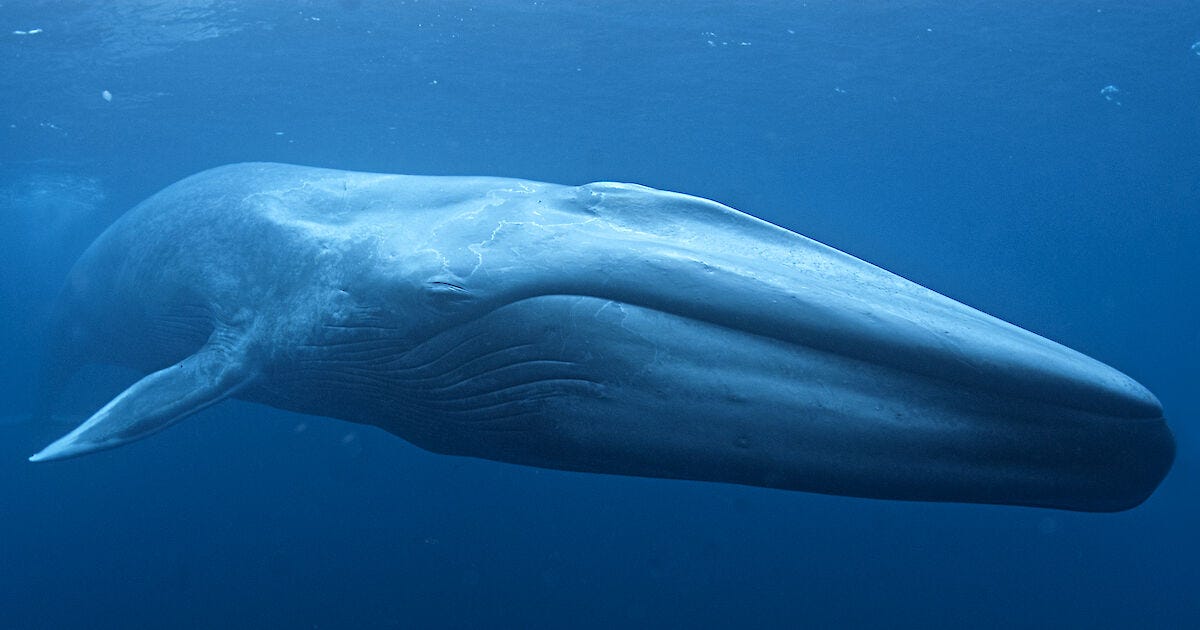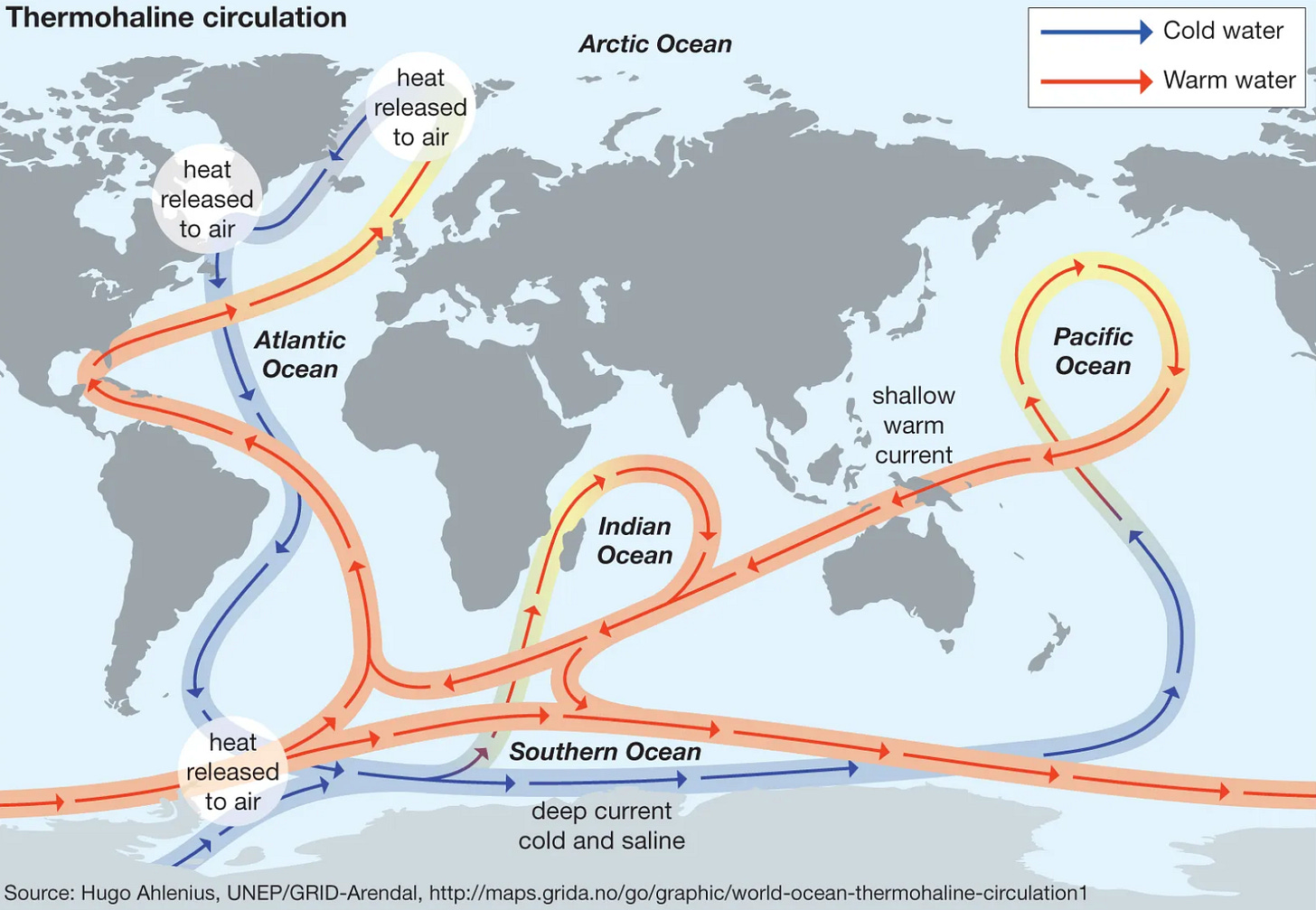We Nearly Killed the Blue Whales Once. Now We’re Doing It Differently.
Why a hidden shift in Antarctica’s deep waters threatens the largest animal on Earth, and all of us
The krill isn’t there. The whales come anyway.
Each summer, blue whales arrive in the Southern Ocean gaunt from migration. They have crossed thousands of kilometres in search of krill, their only chance to recover. These months are sacred. Feed now, or starve later.
This year, the signal is clear, surveys and satellite data show fewer krill in traditional feeding zones. In parts of the Southern Ocean, krill stocks have dropped by half since the 1970s. Blooms now arrive later, shift south, or fail to appear at all.
Scientists think they know why. It starts with salt.
A quiet rupture in the deep
No iceberg collapsed. No penguin died on camera. Still, this may be one of the most underreported climate signals of the year.
For the first time on record, Antarctic deep water is getting saltier.
A new study published last week in PNAS, led by Dr Alessandro Silvano at the University of Southampton, analysed 20 years of data south of 60°S, the icy edge of Antarctica. It revealed a sharp rise in salinity in a region that helps drive global ocean circulation.
This matters more than it sounds.
In the Southern Ocean, cold, salty water sinks to the seafloor, dragging upper layers down with it. This sinking motion helps power the Atlantic Meridional Overturning Circulation (AMOC), a massive conveyor belt that moves heat, oxygen and nutrients around the planet.
For years, scientists warned that glacial melt was diluting this system, making the water fresher, lighter, and less able to sink. That trend has now reversed.
Since the 1990s, salinity in Antarctic deep water has increased by 0.02 to 0.03 PSU (Practical Salinity Units).
That might seem small. It isn’t.
The deep ocean is ruled by fine-tuned density differences. Even a tiny change in salt or temperature can shift where water sinks, floats, or flows. A spoon of salt in the wrong place can reroute a current that spans the globe.
This salinity spike could be gravity’s new accomplice, pulling water downward faster and deeper, altering the very rhythm of vertical mixing and nutrient flow.
Change the inputs, and you change the entire system.
What’s driving the salt surge?
In some parts of Antarctica, less ice is melting, so the ocean isn’t getting as much fresh water. More sea ice is forming, and when it freezes, it squeezes salt into the surrounding water. At the same time, stronger winds are stirring the surface, helping that extra salt mix into deeper parts of the ocean.
This isn’t a climate change pause. It’s a rearrangement.
Glacial melt may be racing ahead elsewhere. Sea ice now forms in new places, thinner, shorter-lived, saltier.
Where is the krill?
A bloom in the Southern Ocean begins with a whisper from the deep. Cold, salty water sinks at the poles, pulling nutrient-rich water upward from below. That rising water carries iron and minerals to the surface, the ingredients life needs to grow.
Phytoplankton take it from there. They bloom in massive numbers, creating a green cloud of food. Krill feed on the phytoplankton, and blue whales follow the krill.
It’s a chain reaction that depends on perfect timing and balance. When the deep water stops rising, the nutrients stay trapped below. The bloom is weaker. Krill struggle. Whales arrive to find the banquet gone.
This is vertical choreography. One misstep, and the entire performance falters.

Scientists have already recorded southward shifts in krill populations. In some areas, krill swarms are becoming less reliable, shrinking, shifting south, or not showing up at all.
A blue whale can’t just switch diets. They evolved for this. Their throat pleats, baleen, migratory rhythms, all fine-tuned to krill.
A comeback in jeopardy
In the 20th century, we nearly deleted blue whales from the planet. Industrial whaling killed 97% of them. It took decades of bans, treaties and conservation work for them to begin returning. Their status has been upgraded from critically endangered to endangered. Progress, but fragile.
Now, they are returning to ancestral feeding grounds, only to find the table empty.
The threat is no longer whalers with harpoons, but the rearrangement of the ocean itself.
The deep is shifting. The surface will follow.
This change hasn’t made the front pages. There are no viral clips or dramatic footage, just a salinity chart plotted south of 60°S.
Yet these waters absorb more heat and carbon than any other region on Earth. They fuel the global climate engine and hold the keys to life at the surface.
A small rise in salt here ripples outward, touching rainfall patterns, fisheries, oxygen levels and storm cycles. It begins with the quiet collapse of a system we thought we understood.
What You Can Actually Do
Push for protection. If your country is part of CCAMLR, tell your MP or government rep to support new marine protected areas in Antarctica. These areas help protect krill habitat and the species that depend on it. Real change happens at the next CCAMLR meeting, they need to hear from you.
Cut carbon fast. Switch to green energy at home, avoid flying when you can, and move your money out of fossil-fuel banks. These choices have a bigger impact than most people think and they ripple through the system.
Back the science. Programmes like Argo, GO-SHIP, and the Southern Ocean Observing System quietly track deep ocean changes. They need more funding, more public backing, and more people paying attention.
Share this story. Talk about it. Send it to whale lovers who care but don’t yet see the climate connection. Tag journalists, educators, and leaders. Help move this from science circles into the mainstream.
If blue whales survive this century, it’ll be because people who cared did more than care. They acted, starting now.
The largest animal on Earth is already responding
Blue whales are not models or metaphors. They are witnesses.
This time, the threats are harder to see.
No ships or harpoons. Only chemistry and silence.
We don’t need to wait for another extinction crisis. We already know how that ends.
The deep ocean is changing. The blue giants are hungry.
That’s the breaking news, buried beneath the waves.
If this story resonated, feel free to share it with someone who needs to remember the ocean too. You can also subscribe to Ocean Rising to get weekly dispatches from the deep.
– Luke
PS: If this shook you, don’t let it stop here. Repost. Restack. Remind someone that the ocean still turns, for now.
Further Reading
Silvano et al. (2025) – The core study revealing rising salinity in Antarctic deep water, published in PNAS.
Haumann et al. (2016) – Shows how sea-ice transport drives Southern Ocean salinity trends (Nature).
Swart et al. (2018) – Links recent Southern Ocean changes to greenhouse gas emissions and ozone depletion (Nature Geoscience).
González-Gambau et al. (2023) – Southern Ocean sea surface salinity maps from satellite data (DIGITAL.CSIC).





Thank you for this! Such an important conversation to be having
Please could you explain your comment about ice increasing elsewhere? Sorry read the reference paper and didn’t see that. It’s a great alert and thank you for crafting still don’t exactly get the reason for increased salinity either - probably misreading and will reread!